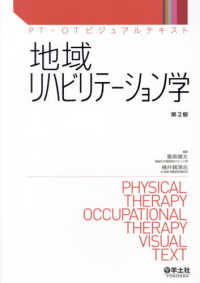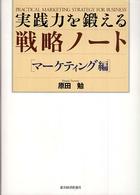- ホーム
- > 洋書
- > 英文書
- > Science / Mathematics
Full Description
This book presents a collection of educational research and developmental efforts on the rapidly emerging use of infrared cameras and thermal imaging in science education. It provides an overview of infrared cameras in science education to date, and of the physics and technology of infrared imaging and thermography. It discusses different areas of application of infrared cameras in physics, chemistry and biology education, as well as empirical research on students' interaction with the technology. It ends with conclusions drawn from the contributions as a whole and a formulation of forward-looking comments.
Contents
Part I: Thermal imaging technology and setups for measurement and application.- Chapter 1 Introduction to the physics of thermal radiation and technology of thermal imaging; Michael Vollmer and Klaus-Peter Möllmann.- Chapter 2 Comparison of IR camera data with theoretical models of heat conduction; Stefano Oss and Giuliano Zendri.- Chapter 3 virtual reality, augmented reality, and mixed reality in infrared light; Charles Xie.- Chapter 4 framing infrared cameras as technology in science education laboratory practice and a practical guide to introducing infrared cameras in science education teaching and research; Jesper Haglund, Fredrik Jeppsson and Konrad Schönborn.- Part II: Science education research on the use of infrared cameras.- Chapter 5 Seeing what they saw: Assessing student learning by analyzing point-of-view thermal videos; Charles Xie.- Chapter 6 physics activities in secondary teaching; Jeff Nordine and Susanne Wessnigk.- Chapter 7 pupils' affective responseto using IR cameras; Anni Loukomies, Kalle Juuti and Jari Lavonen.- Chapter 8 social semiotics analysis of pupils' practical work with IR cameras; Niklas Åhman and Fredrik Jeppsson.- Chapter 9 introduction of IR cameras as a digital technology in preschool; Jeanni Flognman, Janni Karlsson and Jesper Haglund.- Part III: Using infrared cameras in the science teaching practice.- Chapter 10 school activities with visible, near-IR and far-IR light from the MUSE project; Gorazd Planinsic and Eugenia Etkina.- Chapter 11 investigation of electromagnetic radiation and electric circuits with IR cameras; Chuon Wong and R Subramaniam.- Chapter 12 using IR cameras in chemistry education; Xinhua Xu, Meifen Wu and Xiaogang Wang.- Chapter 13 use of infrared camera in medical education; Urban Eriksson and Nina Reistad.- Chapter 14 introduction of IR cameras in physics teaching in a South African township setting; Gilbert Dolo, Leon Grové, Jesper Haglund, and Konrad Schönborn.- Chapter 15 introduction of IR cameras in science centre activities; Karljohan Lundin Palmerius, Andreas Larsson, and Schönborn.








